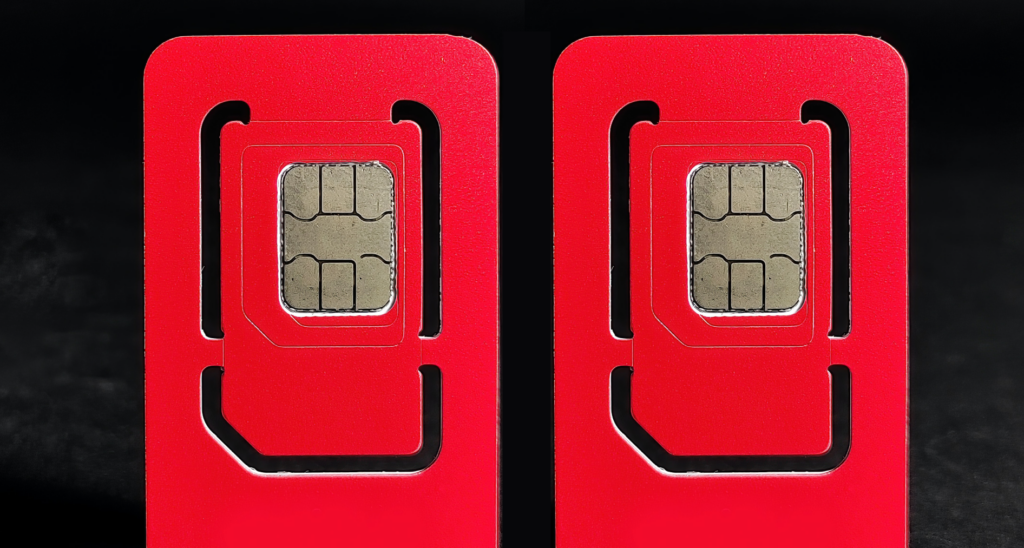Two telephone numbers on one smartphone: sounds like a convenient method to separate private calls from your business number, right? But how does Dual SIM work on iPhones?

What Is Dual SIM / eSIM?
To put it simply, Dual SIM is a relatively new feature on iPhones which allows you to have two different SIM cards on one iPhone. The second SIM is actually a digital eSIM, and you can have more than one extra eSIM if you wish. This allows you to activate another cellular plan from your contract carrier on your phone.
Once done, you’ll have access to two different telephone numbers, and this offers a couple of advantages.
No Need to Swap SIM Cards
The first clear advantage is pretty self-explanatory. Having access to two SIM cards on the device saves you the hassle of having to manually swap SIM cards. Swapping SIM cards by hand isn’t exactly enjoyable, and the small SIM cards can be easily lost in the process. If you travel and swap between different local providers often, this could be a nice time saver.
Second Option for App Verification
It is now common for apps to request a telephone number for identification, including apps like WhatsApp or Clubhouse. Whether it is due to the data policy of the service you wish to use or any other factor, you might not be inclined to give out your main number just to use an app. With a dual SIM, you have another number which you can use.
Separate Work and Personal – Optimized Further by BYOD
Dual SIM can make a lot of sense at work, especially in combination with a Bring-Your-Own-Device approach.
BYOD and Dual SIM are actually two fundamentally different concepts: while BYOD enables the use of private smartphones and tablets for business applications, Dual SIM is merely about using two different numbers on one phone. Both concepts can however be very usefully combined.
One of the basic principles of BYOD is the separation of contacts, so that neither private contact details enter the company network nor do contact details of business contacts or employees find themselves in private apps. For this purpose, the apps on the iPhone are divided into managed and unmanaged apps. A data exchange between these two categories cannot take place.
Example Scenario: eSIM for WhatsApp Combined with BYOD
In the WhatsApp example, the iOS Contacts app and WhatsApp would be defined as an unmanaged app, i.e. a private app. Microsoft Outlook Exchange, on the other hand, would be defined as a managed app.
If WhatsApp is set up on an iPhone with a mobile device management solution, WhatsApp can only access the addresses created in the Contacts app, but not company contacts from Microsoft Outlook Exchange or another company address book.
At the same time, WhatsApp can use the phone number of the private SIM card. As a result, thanks to Dual SIM and BYOD, it is possible to configure an iPhone in such a way that WhatsApp only uses the private phone number and also only accesses the private contacts.
Does My iPhone Support Dual SIM?
Dual SIM is supported by all iPhones since 2018, in other words Dual SIM has been supported since the release of iOS 13. Specifically, these are the following iPhones iPhone XS, iPhone XS Max, iPhone XR, iPhone 11, iPhone 11 Pro, iPhone 11 Pro Max, iPhone SE (2020), iPhone 12 Mini, iPhone 12, iPhone 12 Pro, iPhone 12 Pro Max.
How Does Dual SIM Work On iPhones?
This setup process explains how Dual SIM works on iPhones, enabling you to make and receive calls and messages with both numbers using typical apps like iMessage and Facetime.
Please bear in mind that an iPhone can only use single cellular network at a given time. 5G and Dual SIM is also only available on iPhone 12, iPhone 12 mini, iPhone 12 Pro, or iPhone 12 Pro Max, and requires iOS 14.5 or later.
- To activate eSIM, start by scanning the QR code your carrier provided.
- Once the Celluar Plan Detected notifcation appears, open it and click “Add”. You may be asked to provide a confirmation code at this stage.
Alternatively, you can use your carrier’s App.
- First head to the App Store and download the corresponding app.
- After you have purchased the eSIM plan, your carrier can assign a celluar plan to your which you just need to install. When a notification saying Carrier Cellular Plan Ready to Be Installed appears, click on it to start the installation process.
- Tap Continue, at the bottom of the screen. Once you have enter the required information, you should be good to go.
Dual SIM: Work/Personal Separation Optimized with BYOD
If you are looking at enhancing the secure use of iPhones and iPads in your organization, or want to enable the seucre use of private apps at work, then learn more about why a cloud-based mobile device management is essential. Find out about its advantages in this free whitepaper: The Beginner’s Guide to Mobile Device Management.